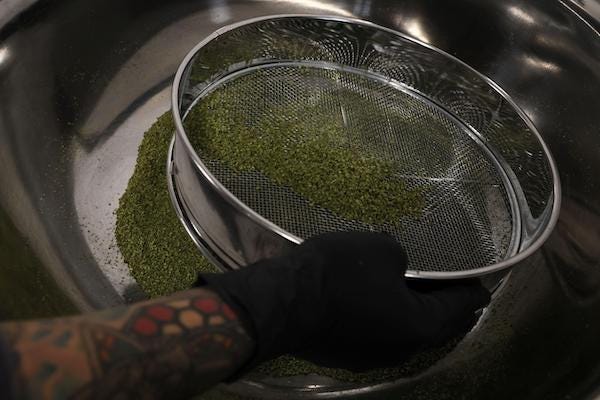Is Dust a Major Concern for the Cannabis Industry?
Powder & Bulk Solids explores how awareness of dust-related health and safety issues in cannabis facilities is growing as the industry expands.

Every industry that works with dry, dusty materials encounters a variety of health and safety hazards from airborne pathogens to combustible dust fires and explosions. The cannabis industry is no exception. These hazards will likely receive more attention in the coming months and years after reports emerged this month of the first fatality of a worker in the cannabis industry linked to dust. The US Department of Labor’s Occupational Safety and Health Administration (OSHA) cited and fined a licensed marijuana facility in Massachusetts after an employee died in January following exposure to ground dried marijuana.
A non-profit organization representing occupational and environmental health and safety (OEHS) professionals, The American Industrial Hygiene Association (AIHA), launched the Cannabis Industry Health and Safety Committee several years ago to explore ways to navigate potential hazards in the cannabis industry. The group is supporting government-backed research on cannabis industry hazards and the distribution of best practices for controlling or mitigating the concerns, as well as employer-employee education outreach programs with state and federal entities to increase knowledge of hazards and how to approach them.
While occupational exposure to all types of dust can lead to negative health outcomes for workers, ranging from mild maladies like inflammation of nasal passages to serious lung diseases, some observers suggest that cannabis dust poses risks that are specific to that industry.
“Many of the exposures in cannabis production are likely to be similar to those experienced in other agricultural or manufacturing operations,” wrote Christopher D. Simpson, a professor and assistant chair for research and faculty engagement in the University of Washington Department of Environmental & Occupational Health Sciences, in a 2020 issue of the Annals of Work Exposures and Health. “However, some exposures are unique in this industry, and there is accumulating evidence that some of these exposures may be associated with adverse health effects in workers exposed to cannabis.”

The worker at the Massachusetts cannabis facility was grinding material and filling pre-roll joints when the exposure occurred. Cannabis is typically ground prior to extraction processes and the production of other cannabis products.
A team of researchers examining occupational health and safety (OHS) hazards in legal cannabis work environments in Australia observed in a 2018 article that “little research has been undertaken on the exposure to inhalable organic dust and other bioaerosols during the commercial cultivation and manufacture of cannabis-based products.” The authors called for a better understanding of the toxicological properties of cannabis dusts as they relate to potential occupational exposures in cultivation and manufacturing environments. Until a standard for cannabis workplace exposure to inhalable organic dusts is created, the researchers posited that Australian hemp facilities should temporarily adopt the respirable cotton dust exposure standard of 0.2 mg/cu m.
“Employees in cultivation and processing facilities may be exposed to allergen and respiratory hazards through the inhalation of organic dusts including fungus, bacteria, and endotoxin as well as VOCs such as diacetyl and 2,3-pentanedione,” wrote the authors of a 2020 paper reviewing the National Institute for Occupational Safety and Health’s (NIOSH) cannabis-related health hazard evaluations and research. “These hazards were most evident during the decarboxylation and grinding of dried cannabis material, where elevated job-specific concentrations of VOCs and endotoxin have been measured.”
Combustible Dust Also an Issue for Cannabis Manufacturers
Beyond potential health impacts, dust also creates a fire and explosion hazard within cannabis facilities. Though these risks have been well known in the hemp fiber processing sites for decades – as handling and processing the dried material generates large amounts of dust – awareness of combustible dust issues in cannabis manufacturing environments appears to be growing in recent years as these facilities increase in size and scale.
Dust created during grinding processes was identified as a fire and explosion hazard in cannabis processing sites in a 2019 seminar by worker’s compensation insurer State Compensation Insurance Fund of California. The presenters offered an array of solutions to mitigate the combustible dust issues in these operations, including the use of dust collection equipment and explosion proof vacuum cleaners, removing fugitive dust from machines, and reducing the number of horizontal surfaces where dust can accumulate.

One sign that regulators and fire safety professionals will pay closer attention to combustible dust risks in cannabis manufacturing operations as the industry matures is that Timothy Heneks, director of engineering services for combustible dust consulting firm Dustcon Solutions Inc., sits on the National Fire Protection Association’s (NFPA) technical committee for NFPA 420, Fire Protection of Cannabis Growing and Processing Facilities. He was named chair of the NFPA 420 Task Group on Drying/Processing in 2022. Another example is that Jason Krbec, sales engineering manager for explosion venting and isolation equipment supplier CV Technology, also serves as a member on the committee.
NFPA started the effort to develop the cannabis industry safety standard in mid-2021 after a previous effort added a chapter specific to marijuana cultivators, processors, and extractors to the 2018 edition of NFPA 1, Fire Code.
What’s Next?
As cannabis production and processing facilities grow in size and number, there will likely be more dust-related health and safety incidents in these work environments in the years to come. Businesses, trade groups, regulators, and workplace safety professionals need to work to mitigate dust hazards in cannabis facilities proactively, drawing lessons and best practices from other industries like food and beverage, agriculture (including hemp fiber and seed processing), and chemicals.
About the Author(s)
You May Also Like




